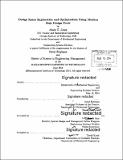Design space exploration and optimization using modern ship design tools
Author(s)
Jones, Adam T. (Adam Thomas)
DownloadFull printable version (16.77Mb)
Other Contributors
Massachusetts Institute of Technology. Department of Mechanical Engineering.
Advisor
Jerod Ketcham and Patrick Hale.
Terms of use
Metadata
Show full item recordAbstract
Modern Naval Architects use a variety of computer design tools to explore feasible options for clean sheet ship designs. Under the Naval Sea Systems Command (NAVSEA), the Naval Surface Warfare Center, Carderock Division (NSWCCD) has created computer tools for ship design and analysis purposes. This paper presents an overview of some of these tools, specifically the Advanced Ship and Submarine Evaluation Tool (ASSET) version 6.3 and the Integrated Hull Design Environment (IHDE). This paper provides a detailed explanation of a ship design using these advanced tools and presents methods for optimizing the performance of the hullform, the selection of engines for fuel efficiency, and the loading of engines for fuel efficiency. The detailed ship design explores the design space given a set of specific requirements for a cruiser-type naval vessel. The hullform optimization technique reduces a ships residual resistance by using both ASSET and IHDE in a Design of Experiments (DoE) approach to reaching an optimum solution. The paper will provide a detailed example resulting in a 12% reduction in total ship drag by implementing this technique on a previously designed hullform. The reduction of drag results in a proportional reduction in the amount of fuel used to push the ship through the water. The engine selection optimization technique uses MATLAB to calculate the ideal engines to use for fuel minimization. For a given speed-time or power-time profile, the code will evaluate hundreds of combinations of engines and provide the optimum engine combination and engine loading for minimizing the total fuel consumption. This optimization has the potential to reduce fuel consumption of current naval warships by upwards of 30%.
Description
Thesis: S.M., Massachusetts Institute of Technology, Engineering Systems Division, 2014. Thesis: Nav. E., Massachusetts Institute of Technology, Department of Mechanical Engineering, 2014. Cataloged from PDF version of thesis. Includes bibliographical references (pages 163-164).
Date issued
2014Department
Massachusetts Institute of Technology. Department of Mechanical Engineering; Massachusetts Institute of Technology. Engineering Systems DivisionPublisher
Massachusetts Institute of Technology
Keywords
Engineering Systems Division., Mechanical Engineering.